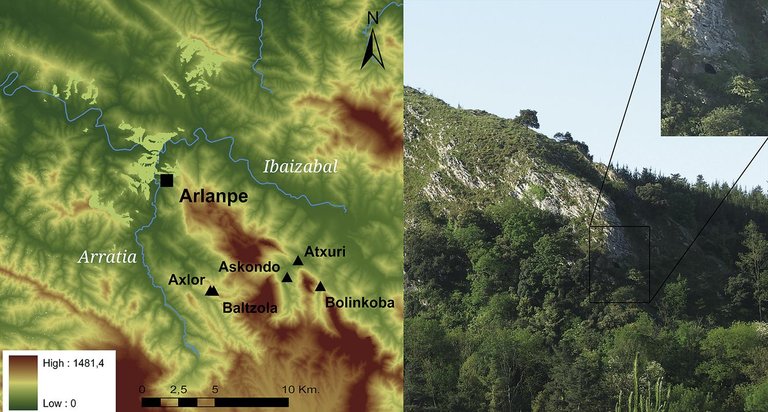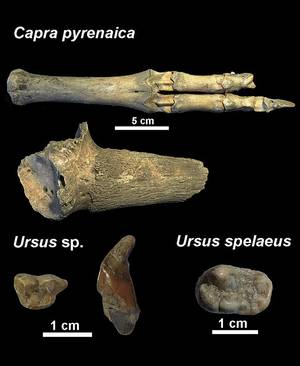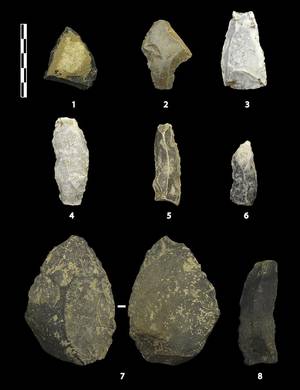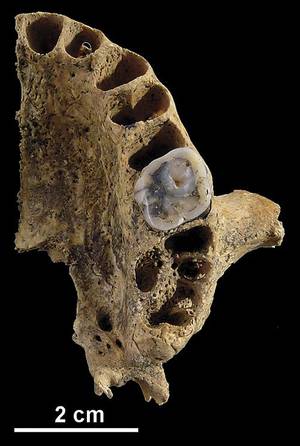Arlanpe: four windows to understand the prehistory of Biscay

The Arlanpe site is located in the valley of Arratia, in the municipality of Lemoa. Although the site was discovered in 1961, its true archaeological potential was revealed with the first surveys carried out in 2006. In general, we can say that the cave of Arlanpe has been used by both humans and other animals in the last 150,000 years. It was used as a refuge for two human species: the Neanderthals, along the ancient Middle Palaeolithic, and our species, especially in the Upper Palaeolithic and the Bronze Age. In the paleolithic strata are remains of hunted animals, the most common are the wild goat ( Capra pyrenaica ) and the sarrio ( Rupicapra pyrenaica ), coinciding with the mountainous area of the area. However, there are also other species of carnivores (see table above) and ungulates, among which stand out deer, deer, snow reindeer, horse or gold, as indicators of other nearby ecosystems.
In the cleaning of sediments, bones of microvertebrates have also been found. Thus, 34 taxa, 23 mammals, six reptiles and five amphibians have been identified in Arlanpe. Due to the close relationship between these species and the medium, changes in taxa and the number of individuals reflect changes in the environment. The same happens with the pollen of the trees and other plants that we have found in the sediment. Finally, we can describe the excavation of the deposits as a controlled destruction process, since the information not collected is lost forever. As has been seen, the sites offer varied information, so the coordinated work of researchers from different fields is essential to obtain the maximum of data.
If we represented the past as a library, the archaeological and paleontological sites would be its paragraphs, pages or leaflets. In the Arlanpe site we have separated four pages that do not go consecutively. The first, and the most important, are the levels corresponding to the Ancient Middle Paleolithic, which are located at the end of the Middle Pleistocene, that is, 200-115 thousand years ago. Besides the scarcity of deposits of this chronology, those of Arlanpe could be one of the oldest of the Cantabrian slope. At these levels, Neanderthal stone tools have been found and information about the environment has been obtained. These groups of Neanderthals manufactured and used different rock tools, mainly in the ARPEGIOS based on lutite or tips and rock scraper (see table on page 48). These groups controlled large areas from Urbasa and Treviño to the coast of Biscay. From the environmental point of view, it seems that the final climate of this time was quite good, and that the forests developed a lot, a sign of an interglacial era.
Another important milestone in the use of the cave was 17,000 years ago. At that time, the hunter-gatherers of Solutrense used to prepare the cave for hunting. These short stays and their interpretation is given by the quantity and morphology of the stone utensils, being especially important the hunting tools. Other utensils are bone and ornaments have also been found, mainly teeth of perforated animals. These archaeological levels are especially important because, despite being within the Solutrense, the beginning of Magdalenian is perceived.
During Magdalenian, about 14,000 years ago, the cave was used symbolically. The hunter-gatherers of the time recorded the schematic figures of the women in a large limestone located in the center of the cave. These engravings resemble those found in France and Germany and are very scarce in the Iberian peninsula. In addition, those of Arlanpe could be one of the oldest discovered in Europe. The expansion of these representations is probably related to the movements to the north of the human groups that occurred at the time the last glaciation ended, at a time when the centre of Europe was a habitable place again.
In the last window of the past offered by Arlanpe (about 3,500 years ago, in the Bronze Age), the cave was used as a tomb. The human bones of this chronology have been found in different areas of the cave. In addition, a central hill may be related to the rites made in this context.
A fifth window, this time out of prehistory, should be placed in the Roman era, IV of the time. In the twentieth century. The cave was used again symbolically, the graves were built and the offers were left together with animal bones.
It is clear that Arlanpe is one of the most important places to know the life of the first inhabitants of Bizkaia and, in addition, provides us with useful information about other moments of the Paleolithic. Together with the studies that are being carried out in other fields (Santa Catalina, Lezetxiki, Bolinkoba, Balzola, etc.) and in which we are working (Aranbaltza, Punta Lucero, Atxurra) to continue completing the library of ecosystems and the prehistory of the Basque Country Quaternary, will be a good grain of sand.


More information More information
Thank you Thank you!
For the work carried out in Arlanpe it has been essential the collaboration of the people who have participated in the excavations. The book published by the Bizkaia Provincial Council is the result of the work of a multidisciplinary team that has participated in the research project. Thanks to the town and town hall of Lemoa, the Provincial Council of Bizkaia, the Basque Government, the Barandiaran Foundation, Eusko Ikaskuntza and the Arpea Cultural Association for their collaboration in excavation and research.
Buletina
Bidali zure helbide elektronikoa eta jaso asteroko buletina zure sarrera-ontzian












